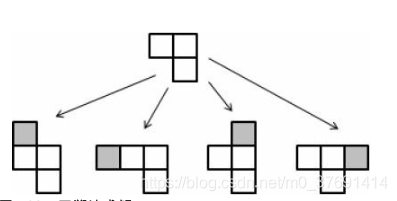UVA1602 Lattice Animals
題目大意
輸入n、w、h(1≤n≤10,1≤w,h≤n),求能放在w*h網格里的不同的n連塊的個數(注意,平移、旋轉、翻轉後相同的算作同一種)。例如,2*4裡的5連塊有5種(第一行),而3*3裡的8連塊有以下3種(第二行)。

題目解析
本題難點在於如何判重,如果採用最簡單的寫法,每個n連塊都會被重複列舉很多次。那麼有沒有好的方法只判重一次呢?答案是當然有的呀,畢竟人類的智慧是無窮無盡的。那麼是什麼方法的,現在由主角
如何用資料結構表示圖形呢?
其實很簡單啦,我們關心的使圖形的形狀而不是位置,每一個圖形都是由若干個格子聯通,那麼我們只需要記錄下n個格子的位置,其整體表示就是圖形的形狀啦。對於格子位置的儲存,不必造輪子啦,只需要用我們強大的set<Cell>
那麼現在來解決的三大難題之圖形的平移、旋轉、翻轉
1、對於平移操作,我們可以定義一個normalize函式,找出x,y分別的最小值minX,minY,那麼它可以視為一個平移向量 (minX,minY),將連通塊的每個單元格都減去該向量,即實現了標準化。
2、對於旋轉操作,我們可以定義一個rotate函式,表示將整個連通塊圍繞座標原點順時針旋轉90度。如何實現呢?只需要將每個格子都順時針旋轉90度即可。相應的幾何變換為(x,y)->(y,-x)。
3、對於翻轉操作,由於既可以沿x軸翻轉,也可以沿y軸翻轉,但實際上沿x軸翻轉後再繞座標原點順時針旋轉180度即可得到沿y軸翻轉的圖案。因此這裡我們定義一個flip函式,表示將一個連通塊沿x軸翻轉。相應的幾何變換為(x,y)->(x,-y)。
那麼如何推出n個格子組成的圖形有多少種呢?
當n>1時,一定是在n-1連通塊的基礎上生成的,即以每個n-1連通塊為基礎,以某一個n-1 連通塊的某個單元格開始,向上下左右4個方向擴充套件。如果可以擴充套件,且不出現重複,就找到了一個n連通塊,加入到集合中來。最終完成n連通塊的列舉。(這也是我們的打表技術啦)
#include<cstdio> #include<algorithm> #include<cstring> #include<set> using namespace std; struct Cell{ int x, y; Cell(int x = 0, int y = 0):x(x), y(y){} bool operator < (const Cell rhs) const { return x < rhs.x || (x == rhs.x && y < rhs.y); } }; typedef set<Cell> Polyomino; #define FOR_CELL(c, p) for(Polyomino::const_iterator c = (p).begin(); c != (p).end(); ++c) inline Polyomino normalize(const Polyomino &p){ //標準化 Polyomino q; int minX = p.begin()->x, minY = p.begin()->y; FOR_CELL(c, p){ minX = min(minX, c->x); minY = min(minY, c->y); } FOR_CELL(c, p){ q.insert(Cell(c->x - minX, c->y - minY)); } return q; } inline Polyomino rotate(const Polyomino &p){ //順時針旋轉90度 Polyomino q; FOR_CELL(c, p){ q.insert(Cell(c->y, -c->x)); } return normalize(q); } inline Polyomino flip(const Polyomino &p){ //向x軸翻轉 Polyomino q; FOR_CELL(c, p) q.insert(Cell(c->x, -c->y)); return normalize(q); } int dx[] = {-1, 1, 0, 0}; int dy[] = {0, 0, -1, 1}; const int maxn = 11; set<Polyomino> Poly[maxn]; int ans[maxn][maxn][maxn]; inline bool flipInFourDir(Polyomino &p, const int &n){ //360 = 90 * 4度旋轉 for(int i = 0; i < 4; ++i){ if(Poly[n].count(p) != 0) return false; p = rotate(p); } return true; } void checkPolyomino(const Polyomino &p, const Cell &c){ Polyomino q = p; q.insert(c); q = normalize(q); int n = q.size(); if(flipInFourDir(q, n) == false) return; q = flip(q); if(flipInFourDir(q, n) == false) return; Poly[n].insert(q); } void generate(){ Polyomino p; p.insert(Cell(0, 0)); Poly[1].insert(p); for(int n = 2; n < maxn; ++n){ for(set<Polyomino>::iterator s = Poly[n - 1].begin(); s != Poly[n - 1].end(); ++s){ FOR_CELL(c, *s){ for(int i = 0; i < 4; ++i){ Cell newc(c->x + dx[i], c->y + dy[i]); if((*s).count(newc) == 0) checkPolyomino(*s, newc); } } } } for(int n = 1; n < maxn; ++n){ for(int w = 1; w < maxn; ++w){ for(int h = 1; h < maxn; ++h){ int cnt = 0; for(set<Polyomino>::iterator s = Poly[n].begin(); s != Poly[n].end(); ++s){ int maxX = 0, maxY = 0; FOR_CELL(c, *s){ maxX = max(maxX, c->x); maxY = max(maxY, c->y); } if(min(h, w) > min(maxX, maxY) && max(h, w) > max(maxX, maxY)) ++cnt; } ans[n][w][h] = cnt; } } } } int main(){ generate(); int n, w, h; freopen("data.in", "r", stdin); while(scanf("%d%d%d", &n, &w, &h) == 3){ printf("%d\n", ans[n][w][h]); } return 0; }
